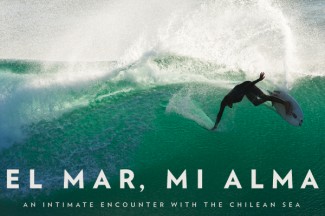El Mar, Mi Alma (Stephen Jones, 2011): Australia
Reviewed by Luke Catena, Santa Barbara Film Festival 2012.
 Being a huge fan of surf videos and documentaries, El Mar, Mi Alma (The Sea, My Soul), immediately caught my attention. Centered around a surf journey down the coast of Chile, this fantastic documentary is not your average “whoa! check out that guy rip!” type of film. Where movies such as Step Into Liquid (2003) and Billabong Odyssey (2003) portray a surf culture and circle around the waves and their fearless conquerors, El Mar, Mi Alma (2011) is much more than that. While it is a documentary with surfing, it is not a surfing documentary.
Being a huge fan of surf videos and documentaries, El Mar, Mi Alma (The Sea, My Soul), immediately caught my attention. Centered around a surf journey down the coast of Chile, this fantastic documentary is not your average “whoa! check out that guy rip!” type of film. Where movies such as Step Into Liquid (2003) and Billabong Odyssey (2003) portray a surf culture and circle around the waves and their fearless conquerors, El Mar, Mi Alma (2011) is much more than that. While it is a documentary with surfing, it is not a surfing documentary.
Shot on 16mm film, by cinematographer Dave Homcy, this movie is beautiful from start to finish. From the lush green grass to the deep blue ocean and everywhere in between; it is easy to identify the star of the film, Chile, itself.
The film opens with colorful, artisan fishing boats floating up and down in the harbor. A man begins the speak (what I presume is Spanish) and subtitles appear at the bottom of the screen, “The sea is the richest thing, here and everywhere. You have to respect the sea.” This quote basically sums up the theme of the movie. Director Stephen Jones interviewed many Chilean locals with questions concerning the beauty and destruction of their country. Problems such as, commercialized fishing, deforestation, improper waste management, and irresponsible animal breeding are major concerns to the well-being and lifestyle of the Chilean people.
Commercialized fishing has decimated the ageless tradition of artisan fishing. Once a prosperous profession, there is simply no way for these small fishing boats to compete with the corporate vessels, monopolizing the ocean. Cities, such as the capitol, Santiago, have poor waste management strategies and most of the runoff ends up in the ocean.
Near the end of the film, the crew arrives to a surf spot at just the wrong time and all the waves are closing out, crushing the surfers. It seems fitting. The ocean is fed up, it cannot take anymore abuse and is seeking retribution. In reality, it was only low tide, however, this scene shows the brute force and immense power of nature, specifically the ocean.
While El Mar, Mi Alma is social commentary and creates awareness of the defamation of a radiant country, the surfing is epic. Left face after left face creates a “goofy foot holy grail” as the surfers effortlessly glide upon glass-like water. However, Jones makes a great choice in not naming any surfers until the final credits, focusing on the landscape, rather than the humans.
And Homcy’s camera work is unbelievable. Using a water-proof housing, he is able to join the surfers in the water and capture incredible footage. What makes his work even more outstanding is the use of film, as opposed to digital. Digital cameras can delete footage with no problem if someone bails on a wave or the wave closes out too soon, this is not the case with film. Homcy had to be selective enough to not burn film, which for an independent shoot also means money; but also daring enough to keep the camera rolling in order to capture some great surfing.
Beautiful footage needs to be accompanied by beautiful music, and Manuel Garcia supplies plenty. A wonderful Chilean folk musician, Garcia’s music works almost too well for this film, but it adds so much to an already great work of art.
One gentleman interviewed for the film states, “The sea is my soul, is my life, is my everything,” and El Mar, Mi Alma captures this portrayal of the Chilean people and culture with sincerity and adoration. I will most certainly be adding this film to my collection of movies whenever it is released.
Visit http://www.elmarmialma.com/ to watch a short version of the film and to find out more about the El Mar, Mi Alma campaign.
About this entry
You’re currently reading “El Mar, Mi Alma (Stephen Jones, 2011): Australia,” an entry on Student Film Reviews
- Published:
- 02.07.12 / 10pm
- Category:
- Documentary, Films, Santa Barbara Film Festival 2012
1 Comment
Jump to comment form | comments rss [?] | trackback uri [?]